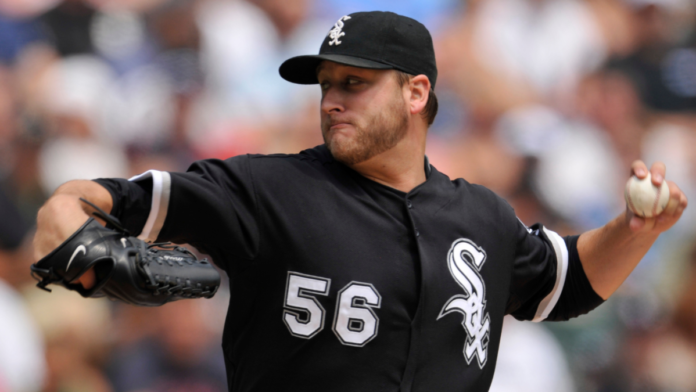Let’s use Mark Buehrle’s Hall of Fame candidacy as a vehicle to discuss why players can stick around for years on the ballot and then see if I’ve changed my mind on him as a possible Hall of Famer.
It’s a discussion point every winter. Vote percentages change for players and, given that they haven’t added any counting stats since the last vote, it seems to confuse some people. With a voting limit and the ballot changing every single year, it’s easy to see how the percentages for some players could change (let’s say a player is the 11th choice for someone one year; if three Hall of Famers fall off the ballot while no new ones come on, that player would then gain a vote the next year, right?). Plus, the voting body changes and lapsed voters have different opinions than new voters.
There’s also another prong and that is a voter honestly changing their mind. I’m not yet a voter, but I’m close and I might be doing just that with Buehrle.
My initial thought when I saw him on the ballot was that he should be a one-and-done and I didn’t think much deeper. He got 11 percent of the vote in his first try and I saw some arguments from people I respected that made me think twice. Now that he dropped to 5.8 percent of the vote last season and is in danger of falling off the ballot, I think he might be worth a deeper dive. So let’s take that plunge.
In parts of 16 years, Buehrle was 214-160 with a 3.81 ERA (117 ERA+), 1.28 WHIP and 1,870 strikeouts in 3,283 1/3 innings. He was a five-time All-Star and four-time Gold Glover. He was 2-0 with a 3.47 ERA and a save in four playoff appearances in 2005 when the White Sox won the World Series for the first time since the Black Sox scandal.
Buehrle doesn’t fare well — at least not at a Hall of Fame level — in JAWS. He’s 78th and there are 66 current Hall of Fame starting pitchers. The average Hall of Fame score is close to Roy Halladay (31st) while Buehrle sits around the likes of Orel Hershiser, Tommy John, Frank Tanana and Andy Pettitte. Those are very good or even great pitchers, but not Hall of Famers.
I do wonder, though, if Buehrle’s workhorse nature merits a bump, especially as starting pitchers increasingly working fewer and fewer innings.
I’ve long thought innings pitched was an underrated stat these days for starters. It shows that the pitcher was, generally speaking, throwing well enough to absorb a lot of work, meaning he kept his team in games and took pressure off the bullpen, which, in turn, helps them on days he isn’t even pitching. It’s a ripple effect with the workhorses.
Buehrle led his league in innings twice, was in the top five five times and the top 10 seven times. After his rookie year, take a look at innings pitched, per season, through the end of his career: 221.1, 239, 230.1, 245.1, 236.2, 204, 201, 218.2, 213.1, 210.1, 205.1, 202.1, 203.2, 202, 198.2. In his final season, a 36-year-old Buehrle led the majors with four complete games. He was truly a throwback workhorse.
In fact, here’s a list of the pitchers with the most 200-inning seasons in the 2000s:
1. Buehrle, 14
2. Justin Verlander, 12
3. James Shields, 10
t4. Zack Greinke, 9
t4. Livan Hernandez, 9
t4. Javier Vazquez, 9
How about that, huh? CC Sabathia and Jon Lester had eight each. Max Scherzer has six. Clayton Kershaw only has five.
Starting pitchers are taking on much less work than in the distant past, but it wasn’t nearly as drastic a few years ago as many people seem to think. In 2015, Buehrle’s last year, starters averaged 5.8 innings per start. It was 5.9 his rookie year in 1999. In 1980, it was 6.3 and in 1960 it was 6.4. In 1940, it was 6.9. So it was a gradual decline, but not to the point that we would be giving Buehrle a ton of extra credit for shorter workloads in his era.
In fact, if we looked at the most 200-inning seasons in a career all-time, Buehrle is in good company. There are only 14 pitches who had 15 200-inning seasons. All but two (Jack Powell and Roger Clemens) are Hall of Famers (list here). And Buehrle was just four outs in his last season from hitting 200 for a 15th time. Those with exactly 14 200-inning seasons: Buehrle, Tom Glavine, Randy Johnson, Nolan Ryan, Jim Kaat, Robin Roberts, Early Wynn, Red Ruffing and Christy Mathewson. Everyone but Buehrle is already a Hall of Famer.
From this point of view, Buehrle was an all-time great workhorse.
Obviously, workload alone shouldn’t get someone into the Hall of Fame, but there’s enough on Buehrle’s resume that I’ll now consider voting for him. I haven’t yet done my hypothetical ballot for this year, but he’ll be in the group after my obvious names where I see if there’s still room to add them before my maximum of 10. If he’s in the top 10 in a few years when I officially get a vote, he’ll have my vote. It’ll be close. We’ll see!
The bottom line, though, is my coming around on Buehrle is a good example of why players are allowed to hang around on the ballot for 10 years. Even if he’s very unlikely to one day get to 75 percent, he’s worthy of our discussion in the slow winter months.


